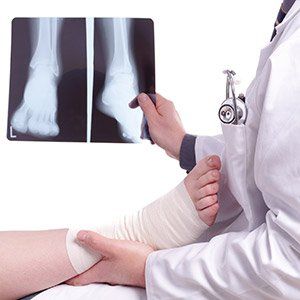BUNIONS
A bunion
is a swelling or enlargement of the big toe joint on the inner side of the foot. The big toe commonly starts to drift toward the second toe. This problem usually begins due to a weakness in the structure of the foot, which allows the bone to drift from proper alignment. Poor fitting shoes hasten these changes.
GANGLION CYST
A ganglion cyst is a fluid filled sac that usually occurs on the side or top part of the foot. Most commonly, it is the result of an injury (i.e. something falling on the foot).
This injury causes a soft type of bump to grow from a joint capsule or tendon.
SYMPTOMS:
Ganglion cysts cause irritation, swelling and pain. Pain can become quite severe if it begins to press on a nerve.
TREATMENT:
In a procedure easily be performed in the office setting, the abnormal tissue is separated from the normal tissue and removed completely.
HEEL PAIN
Heel pain is a foot problem that affects people of all ages. Often called "Policeman's Heel," it is common to people who stand or walk on their feet for long periods of time (i.e. nurses, waitresses and sales people).
SYMPTOMS:
Pain with first step in the morning is most common. This gradually eases after 10-20 minutes (loosens up). However, each time you sit or lay down the same scenario begins. As the problem becomes more longstanding, pain becomes worse after the initial loosening up period. Eventually every step is painful.
TREATMENT:
X-rays are required to determine if a spur has grown on the bottom of the heel bone. Oral medications, injectable medications and orthotics (custom arch supports) often help to alleviate the pain of the heel spur syndrome. Cases that are not improved by conservative care become surgical candidates. This author has perfected a heel surgery procedure and is able to perform the procedure through a pinhole on the bottom of the heel. This new method greatly minimizes the recovery period.
INGROWN NAIL PROBLEMS
An ingrown is the result of a nail growing into the skin that surrounds it. This can occur on either edge of any toenail. Ingrown nails may be caused by inappropriate trimming, inherited nail deformities, injuries, fungal infection or pressure from shoes.
SYMPTOMS:
An ingrown nail causes pain at the tip of the toe, which may extend to base of the toe if severe. Standing or walking may aggravate the ingrown nail causing it to worsen. An ingrown nail may lead to infection or inflammation with pus.
EVALUATION:
It should be performed by a podiatrist familiar with this affliction.
TREATMENT
This procedure may be easily performed in the office setting. The ingrown portion of the nail may be temporarily or permanently removed (just slightly narrowing the nail from the ingrown side).
NEUROMAS
Neuromas, commonly called Morton's Neuroma, begin when the outer coating of a nerve in your foot thickens. This thickening is usually caused by irritation to the nerve, typically between the third and fourth toes.
SYMPTOMS:
Neuroma pain usually begins slowly, causing a burning, cramping or numbness type of discomfort/pain. These symptoms are more likely to occur after long walks or standing for extended periods of time. As the irritation continues, the nerve gets larger and the symptoms become more severe. Sometimes the inflammation may affect the area the following day. When the pain occurs, you may need to take your shoe off and rub the area. In some cases, the pain may radiate to the tips of the toes or shoot back to the heel area.
TREATMENT:
Once a Morton's Neuroma has been diagnosed, various treatment options are available: oral medications, injectable medication, orthotics (custom made arch supports which help support the foot and prevent compression in the nerve), physical therapy and surgery. Surgery is only necessary after some or all of the conservative treatments have failed. This procedure (removal of the small piece of enlarged nerve) may easily be performed in the office setting.
WARTS
Warts are caused by a virus. The wart is often contracted by walking barefoot on dirty surfaces or littered ground where the virus is lurking. They typically invade the skin through small cuts or abrasions. These are contagious and may spread to other parts of the foot or body. They may grow as isolated islands or in large clusters.
"Plantar" refers to the bottom of the foot, where worts are usually found. Plantar warts are often mistaken for corns or calluses on the sole of the foot. Plantar warts tend to be flat and rough surfaced with well-defined borders and little black, brown or red spots, which are the blood vessels that are feeding them.
Children and teenagers tend to be more susceptible to warts than adults.
SYMPTOMS:
As these grow they begin to cause sharp burning pain and affect the way a patient walks. They are unsightly as well.
TREATMENT:
Unfortunately, the over-the-counter topical acids are usually unable to get to the "root," and are therefore ineffective for warts on the bottom of the foot.
The procedure is easily performed in the office. The wart is scooped out with a special instrument, and then the base is cauterized either electrically, chemically, with a laser or in combinations to minimize the chance of re-infection.

